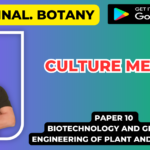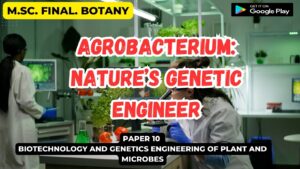![]()
History of Biotechnology
- 500 B.C.: In China, the first antibiotic, moldy soybean curds, are put to use to treat boils.
- 1675: Leeuwenhoek discovers bacteria.
- 1761: English surgeon Edward Jenner Pioneers vaccination, inoculating a child with a viral smallpox vaccine.
- Gottlieb Haberlandt, – Father of Tissue Culture (1902), developed the concept , the culture of isolated cells of Tradescantia in in vitro conditions.
- Hanning – 1904: Isolated embryos of some crucifers and cultured successfully on mineral salt and sugar solution.
- Simon (1908) -regenerated callus from poplar trees on the surface of medium containing IAA which induced call division.
- R.P. White, Gautheret and Nobecourt (1930) -independently cultured tissues excised from several plant on the defined nutrient media.
- 1941 – Van overbeek and co-worker used Coconut milk for embryo development and callus formation in Datura.
- Skoog and coworker – recognized the role of cytokinine in tissue cultural.
- 1948 – Skoog and Tsui – found adenine in the presence of auxin to induce callus growth and bud formation in tobacco cultures.
- 1953. Muir. Develop nurse-culture technique
- 1955 – Miller et al. isolated and identified kinetin. Later on other cytokinin like zeatin and isopentyl adenine were discovered.
- 1957. skoog and Miller-gave hypothesis of organogenesis in callus by varying the ratio of Auxin and cytokinin
- 1958 FC Stewart and J Reinert obtained regeneration in callus tissue culture of carrot and proposed the concept of Totipotency in plant cell.
- 1960. Role of enzymes cellulose and pactenase was recognized and Cocking developed the techniques of protoplast culture.
- 1964: Pasteurization
- 1965: Medal and modern genetics
- 1965. Vasil-and Hilderbrandt -fully developed the phenomenon of totipotency by demonstrating that a single isolated cell can regenerate into a whole plant
- 1966 – Guha and Maheshwari developed the technique for the culture of pollen embryos and sporogenous tissue of anther.
- 1970: Breeders crossbreed cotton, developing hundreds of varieties with superior qualities.
- 1870: The first experimental core hybrid is produced in a laboratory.
- 1900: Drosophila (Fruit flies) used in early studies of genus.
- 1911: American pathologist Peyton Rous discovers the first cancer – causing virus.
- 1926: Hybridization
- 1928: Scottish Scientist Alexander Fleming discovers Penicillin.
- 1933: Hybrid corn is commercialized
- 1942: Penicillin is mass produced in microbes for the first time.
- 1950’s: The first synthetic antibiotics created.
- 1951: Artificial insemination of livestock is accomplishedusing frozen semen.
- 1953: Discovery of DNA structure.
- 1978: Recombinant human insulin is produced for the first time.
- 1979: Human growth hormone is synthesized for the first time.
- 1980: Small pox is globally eradicated following 20 year mass vaccination effort.
- 1980: The U.S. Supreme Court approves the principle of patenting organisms, which allows the Exxon oil company to patent an oil-eating microorganism.
- 1981: Scientists at Ohio University produce the first transgenic animals by transferring genes from other animals in to mice.
- 1982: The first recombinant DNA vaccine for livestock is developed.
- 1982: The first biotech drug, human insulin produced in genetically modified bacteria, is approved by FDA. Genetech and Eli Lilly developed the product.
- 1985: Genetic markers are found for kidney disease and cystic fibrosis.
- 1986: The first recombinant vaccine for humans a vaccine for hepatitis-B, is approved.
- 1986: Interferon becomes the first quticancer drug produced through biotech.
- 1988: The first pest-resistant corn, Bt-corn is produced.
- 1990: The first successful gene therapy is performed on a 4 year old girl suffering from an immune disordered.
- 1992: FDA approves bovine somatotropin (BST) for increased milk production in dairy cows.
- 1993: The FDA approves Betaseron, the first of several biotech products that have had a major impact on multiple sclerosis treatment.
- 1994: The first breast cancer gene is discovered.
- 1994: The Americans are certified polio free by the International Commission for the Certification of Polio Eradication.
- 1995: Gene therapy, immune system modulation, and recombinant produced antibodies enter the clinic in the war against cancer.
- 1996: A gene associated with Parkinson’s disease is discovered.
- 1996: The first genetically engineered crop is commercialized.
- 1997: A sheep named Dolly in Scotland becomes the first animal cloned from an adult cell.
- 1998: FDA approves Herceptin a pharmacogenomic breast cancer drug for patients whose cancer over expresses the HERZ receptor.
- 1999: A diagnostic test allows quick identification of Bovine Spongicorm Encephalopathy (BSE also known as “man cow” disease) and CreutzfeldtJacob disease (CJD).
- 2000: Kenya field – tests its first biotech crop, virus resistant sweet potato.
- 2001: A gene targeted drug for patients with chronic myeloid leukemia. Gleevec is the first gene targeted drug to receive FDA approval.
- 2002: EPA approves the first transgenic rootworm resistant.
- 2002: The beuteng an endangered species is cloned for the first time.
- 2003: China grants the world’s first regulatory approval of a gene therapy product, Gendicine, which delivers the P53 gene as a therapy for squamous cell head and neck cancer.
- 2003: The human genome project completes sequencing of the human genome.
- 2004: A food and agriculture organization endorses biotech crops, stating biotechnology is a complementary tool to traditional forming methods that can help poor farmers and consumers in developing nations.
- 2004: FDA approves the first antiangiogenic drug for cancer, avastin.
- 2005: The Energy Policy Act is passed and signed into law, authorizing numerous incentives for biotechnology development.
- 2006: FDA approves the recombinant vaccine Grandsil, the first vaccine developed against human papilloma virus (HPV), an infection implicated in cervical and throat cancers, and the first preventive cancer vaccine.
- 2006: USDA genetics Dow Agrosciences the first regulatory approval for a plant made vaccine.
- 2007: FDA approves the H5N1 vaccine, first vaccine approved for avian flu.
- 2009: Global biotech crop acreage reaches 330 million acres.
- 2009: FDA approves the first genetically engineered animal for production of a recombinant form of human antihrombin.
- 2009: Cedars – Sinai Heart Institute uses modified SAN heart genes to create the first viral pacemaker in guinea pigs, now known as iSAN’s.
- 2010: Researcher at the J. Craig Venter Inst. Create the first synthetic cell.
- 2012: 31 years old Zac Vawter successfully uses a nervous system controlled bionic leg to climb the Chicago Willis Tower.













